Abu Mahdi missile is an Iranian long-range surface-to-surface and anti-ship cruise missile that was developed by the Aerospace Industries Organization (AIO) of Iran’s Ministry of Defence. This missile is the first Iranian land-attack cruise missile (LACM) capable of executing both anti-ship and land-strike missions. This missile was unveiled in 20 August 2022 and reached mass production in 2023.
The Abu Mahdi cruise missile was developed and built under the “Meshkat” project. The project Mashkat is a project in which the Russian KH-55 cruise missile was reverse engineered by Iran; And based on that, at first the Ya-Ali cruise missile with a range of 700 km, then the cruise missiles Soumar with a range of 700 km, Hoveyzeh with a range of more than 1,300 km and finally an anti-ship cruise version named “Abu Mahdi” with a range of more than 1,000 km were made. The Meshkat project has another long-range cruise missile that has not been officially unveiled and there are no pictures of it.
Abu Mahdi cruise missile is the first Iranian naval cruise missile with a range of 1000 km, which can be used against both sea and land targets, And can be launched from the fixed and mobile ground launchers and warships. Therefore, this missile with such a range is considered among the strategic cruise missiles.
It is worth noting that few countries have the ability to domestically manufacture such a cruise missile in this range and more ranges, and other countries have to pay exorbitant costs to purchase this type of strategic cruise missile. For example, Russian Kalibr, the US’s Tomahawk and French MdCN cruise missiles are included in this category.
History:
The long-range cruise missile “Martyr Abu Mahdi Al-Muhandis” was unveiled for the first time together with ballistic missile “Martyr Haj Qasem” in August 20, 2020, on the occasion of Iran’s Defense Industry Day. At the unveiling ceremony, Amir Hatami, the then Minister of Defense, stated that the range of this cruise missile is more than 1000 km.
At the time of the unveiling, a video of the test-fire of the Abu Mahdi missile was published, with the words “Talaiyeh” written on it. According to the process of naming cruise missiles from Soumar, Hoveyzeh and then Paveh, using the names of war zones of the Iraq-Iran war on Iranian ground cruise missiles is a common practice in Iran. However, with the martyrdom of this prominent resistance commander, Abu Mahdi Al-Muhandis, Iran put the name of this martyr on the country’s first land-attack cruise missile.
This missile with changes in the engine section and with a new name was unveiled again on July 25, 2023 during a ceremony and its mass production line was officially opened by the Ministry of Defense of Iran. Also, in this ceremony, the Abu Mahdi missile officially entered the service of the IRGC and Army combat units.
Design:
Abu Mehdi long-range cruise missile has used the features of Soumar and Hoveyzeh cruise missiles in its design. According to the published images, different parts of the Abu Mahdi missile can be examined as follows:
The main radar of the missile is located in the nose, and after the radar, a compartment or cabin is intended for the computer.
After the radar is the warhead, which is indicated by the words WARHEAD CABIN on the missile. Abu Mahdi cruise missile uses a penetrating warhead with a 410-kilogram high-explosive warhead that can cause a lot of damage to the target.
After the warhead, there is a ground detection radar and other missile guidance systems.
In the middle section, the missile wings and the fuel tank are located. This missile has folding wings structure that allow it to be placed inside the sea and land launch containers. The Abu Mehdi’s wings use a square design with a round tip, which is completely identical to the previous design.
The fuel tank and the wings are placed in one part, and the fuel tank extends to the missile engine, And the engine is placed under the missile. At the time of the initial unveiling in August 2020, the Abu Mehdi’s engine was similar to the Hoveyzeh cruise missile engine; But in the version that was unveiled in 2023 and has reached mass production, a different engine is used. The name of this engine has not been officially announced, but it can be assumed that this engine is an optimized turbojet engine (probably Tolou type) with the same flight conditions as the initial unveiling model.
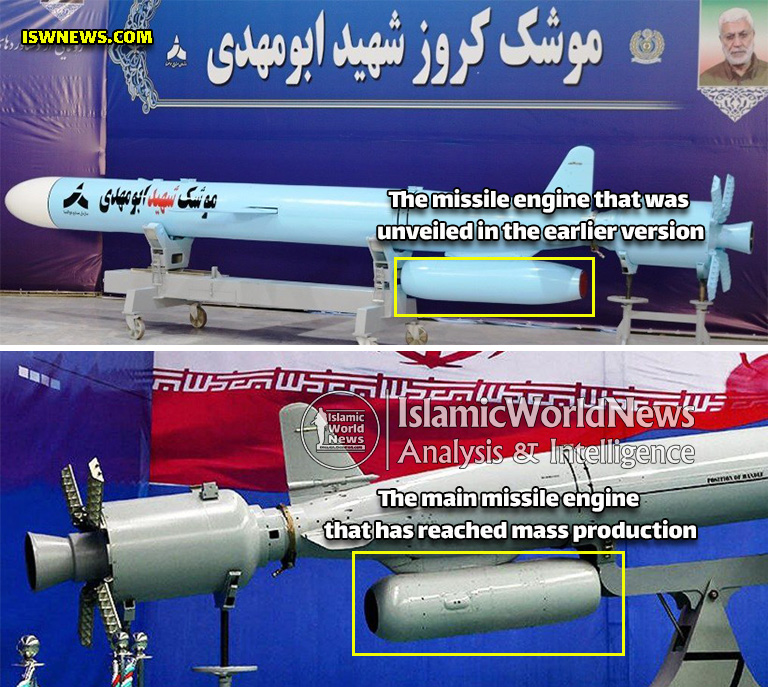
The engine difference between the prototype version and the mass-produced version of the Abu Mahdi cruise missile
At the end of the missile, there are control fins and rocket booster. The control fins are responsible for changing the direction of the missile. The Abu Mahdi cruise missile uses a large booster with retractable mesh stands like the Hoveyzeh and Soumar models.
Close-up video of the Abu Mahdi missile and its launcher box
A video of the test-fire of the Abu Mahdi cruise missile from the ground mobile launcher and testing the guidance and accuracy of this missile
In the case of the Abu Mahdi missile, considering the high range of the missile and the fact that it engages with sea targets that are mobile, two issues are very critical. The first issue is the initial detection of the target and the second issue is guiding the missile towards the moving target.
Detecting the target in the sea and correcting the missile’s flight path in relation to the moving target:
Abu Mehdi cruise missile has a range of 1000 km, which definitely takes more than an hour to travel such a distance. Considering that this cruise missile is designed based on the KH55 missile and the KH55 has a speed of about 700 km/h, then the Abu Mehdi cruise will probably have a speed approximately equal to this missile, and this means that it will take about 85 minutes to travel a distance of 1,000 km. If a ship is traveling at 32 knots (about 60 km/h), then it has moved about 85 km from its initial location since the missile was fired, and finding such an object is beyond the capabilities of the missile’s small seeker radar.
One of the method to solve this problem is to use helicopters, fighter jets, fast boats or drones. All these items are at risk of discovery and destruction. However, the use of stealthy drones such as Shahed-171 greatly increases the probability of success in detecting and chasing the vessel.
Another method is to use spy satellites to discover the primary and the secondary position of the target. It is also possible to track the radar by the radars of surface vessels and coastal radars. It is also possible to use the radars of surface vessels and coastal radars to track the target.
Missile guidance systems
1- The main seeker and radar:
RADAR HATCH is written on the nose of the missile. This brings to mind that the main radar can be accessed through this hatch and it is possible to change the mode of the radar; In other words, this hatch is for the radar adjustment and checkup.
This missile uses active radar homing (ARH) and passive radar (PRH). It is also possible to use both modes. For example, the missile can use the passive mode until it approaches the target and use its active radar mode when it is near the target.
In another image, there is a hatch with the words ATB CABIN. This hatch is for access to the radar processor. Also, this cabin has a small air intake for cooling.
– Active radar homing (ARH):
It is a missile guidance method in which the missile containing a radar transceiver and its special computer independently tracks the target in the final stage of guidance. In this method, the missile is sent to the target position, and if the target characteristics are changed, new characteristics are sent to it along the way.
Considering Abu Mahdi’s range of 1000 km, this radar method will be active during target detection, which is suitable for attacking land targets and sea targets. Of course, this radar can also help the flight system during the flight.
– Passive radar homing (PRH):
Passive radar is a radar systems that detect and track objects by processing reflections from non-cooperative sources of illumination in the environment. Passive radar is not able to produce radar waves, but this type of radar has the ability to detect the sources of the waves and allows it to attack the radar of air defense systems. Missiles with passive radars are very hard to detect, but easier to break their locks. These types of radars require very powerful computers to be able to separate and process a large amount of environmental waves.
In the case of the Abu Mahdi missile, due to the lack of sufficient space, there is only the possibility of having a small advanced computer to detect the radar waves and its propagation direction, which can be used to attack radar targets.
According to the published video of Abu Mahdi cruise missile test, several corner reflectors are used in the upper part of the target, which is to engage the missile’s radar, and the missile finally hits the middle part of the metal structure, which is completely similar to the performance of conventional anti-ship cruise missiles. High accuracy of hitting the target is seen in the tests.
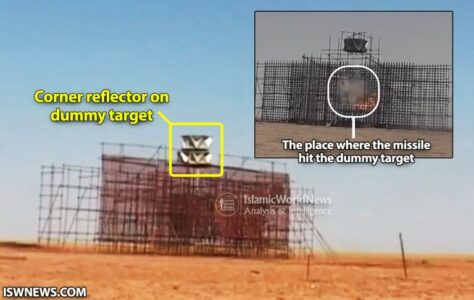
The corner reflector on the dummy target and the point where the missile hits the middle of the dummy target
This method of target detection was also used for anti-ship missiles such as Ghadir, Ghadr, Kosar, etc. In this method, the missile finds the target using its search radar and then scans the target and finds the middle part of the target and attacks it. This collision causes maximum damage to the vessels, which ultimately leads to the vessel being split in half and sinking.
2- Inertial guidance:
An inertial navigation system (INS) is a navigation device that uses motion sensors (accelerometers), rotation sensors (gyroscopes) and a computer to continuously calculate by dead reckoning the position, the orientation, and the velocity (direction and speed of movement) of a moving object without the need for external references, which keeps the position of the missile on its right path.
3- GPS guidance:
In this method, the missile is guided to the target using the Global Positioning System (GPS). This system, along with the inertial guidance system, can greatly increase the accuracy of the missile. The accuracy of some types of missile with this type of guidance reaches an accuracy of less than 1 meter. It is also possible for Abu Mahdi to access GLONASS and BeiDou navigation systems, which is the Russian and Chinese version of GPS.
4- TERCOM system:
Terrain contour matching or TERCOM uses a contour map of the terrain that is compared with measurements made during flight by an on-board radar altimeter. A TERCOM system considerably increases the accuracy of a missile compared with inertial navigation systems (INS). The increased accuracy allows a TERCOM-equipped missile to fly closer to obstacles and at generally lower altitudes, making it harder to detect by ground radar.
Topographical maps are very accessible today because they are used for commercial purposes and Abu Mehdi takes advantage of this.
In the lower part of the Abu Mahdi missile, a part with a different shape and material can be seen, which seems to be the location of the altimeter radar or terrain detection. This radar is responsible for a part of the mission for guiding the missile along with the INS, And it significantly increases the accuracy of the missile.
The technical specifications of the Abu Mahdi long-range cruise missile have not been officially announced, but considering the family of missiles in project Meshkat, and also the technical specifications of the KH55 cruise missile, it is possible to accurately estimate the specifications of the Abu Mahdi cruise missile, which we will mention below.
Abu Mahdi cruise missile specifications:
Type: Land-attack and anti-ship cruise missile
Unveiled: 20 August 2020
Origin: Iran
Manufacturer: Aerospace Industries Organization (AIO)
Length: 600 cm
Wingspan: 310 cm
Diameter: 55 cm
Weight: 1650 kg
Warhead: 410 kg HE
Accuracy: 3 meters CEP
Range: more than 1000 km
Flight altitude: under 50 meters
Guidance: GPS/INS – TERCOM – ARH/PRH
Engine: Turbojet
Speed: about 700 km/h
Launch platform: Fixed and mobile ground launchers and ships
More pictures of the Abu Mahdi cruise missile:
Click to see the full-size image



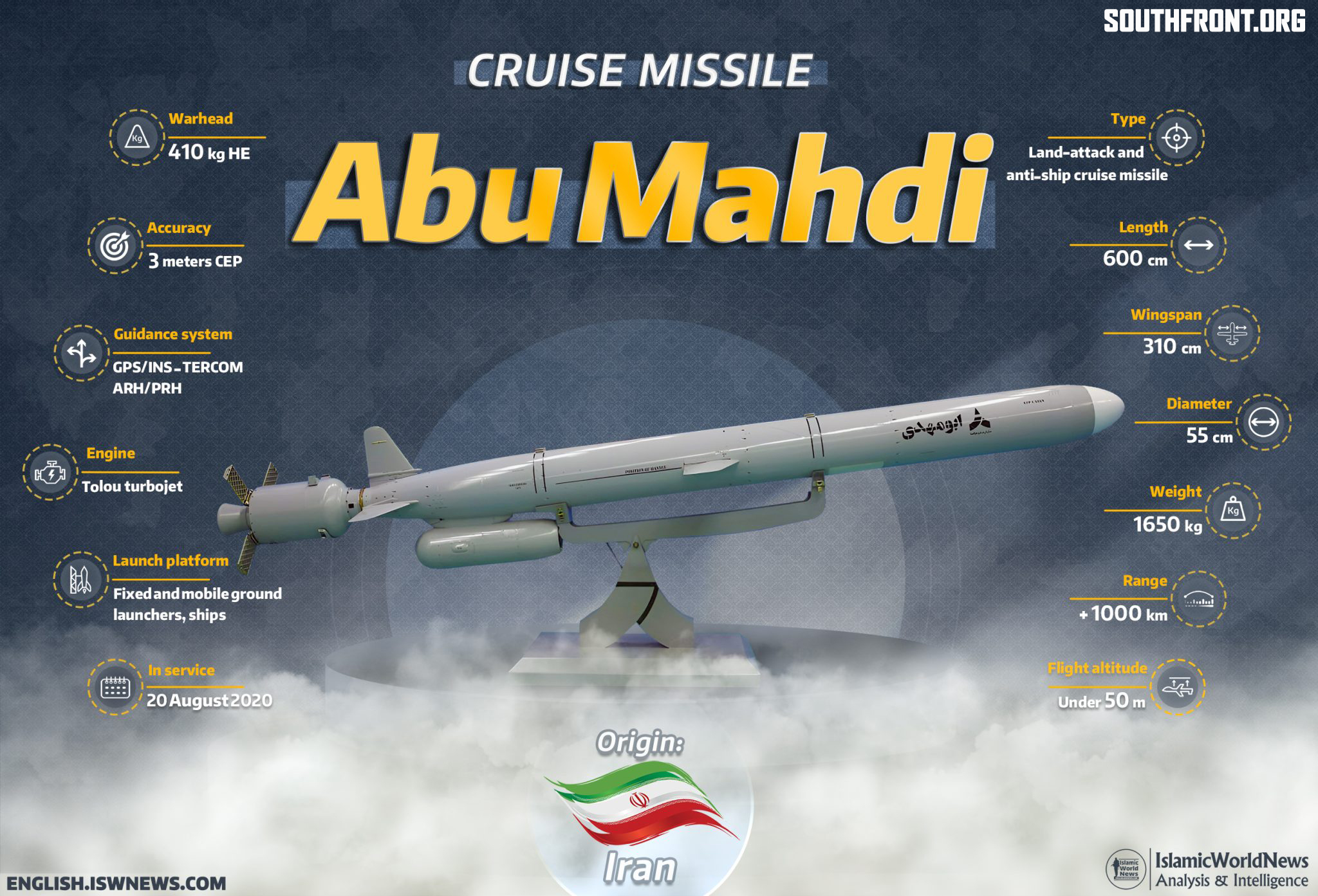
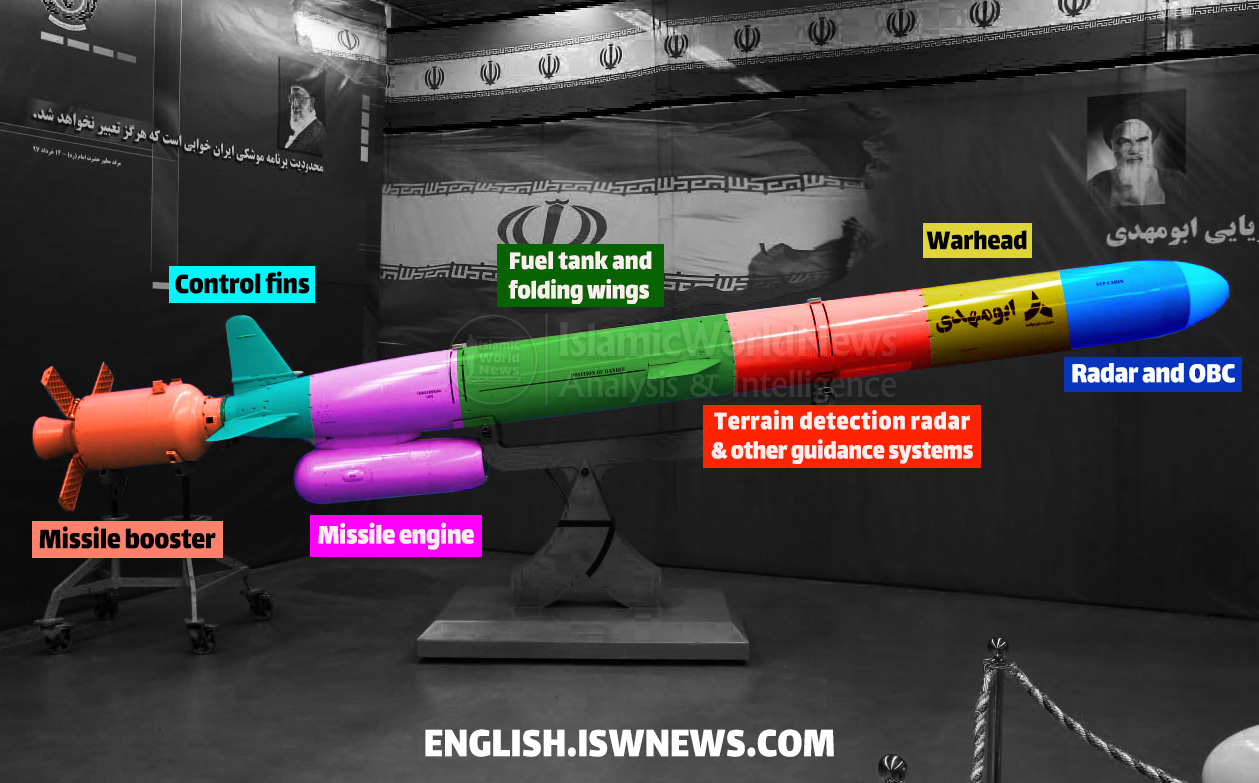
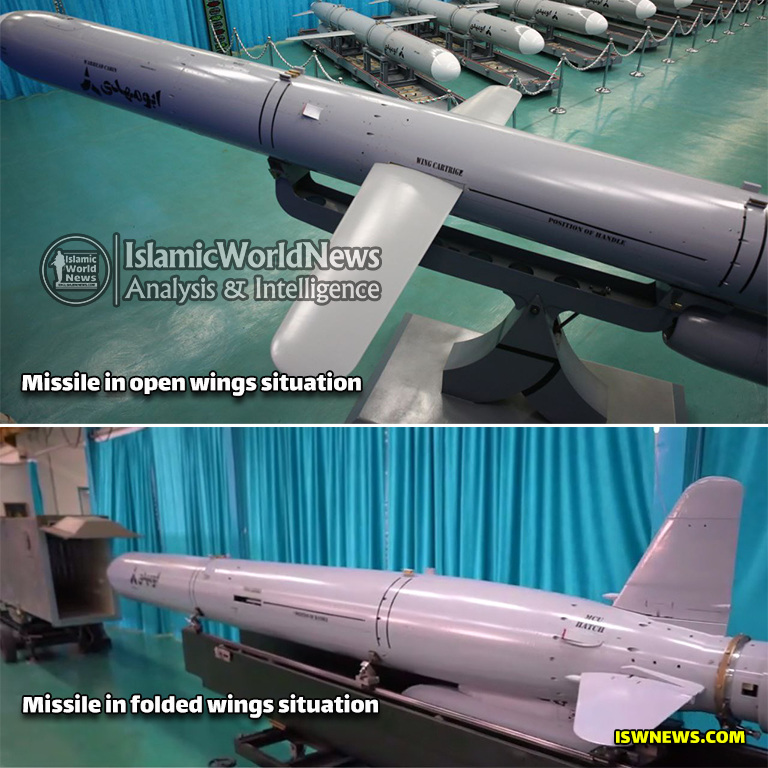
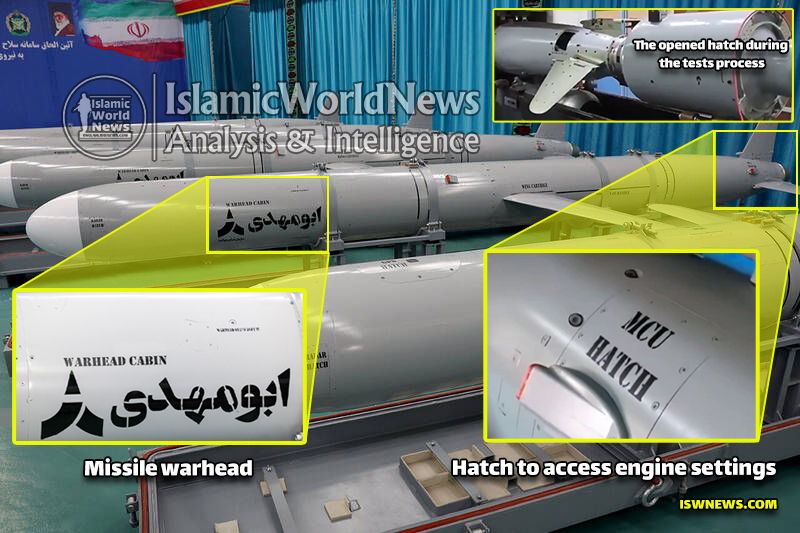
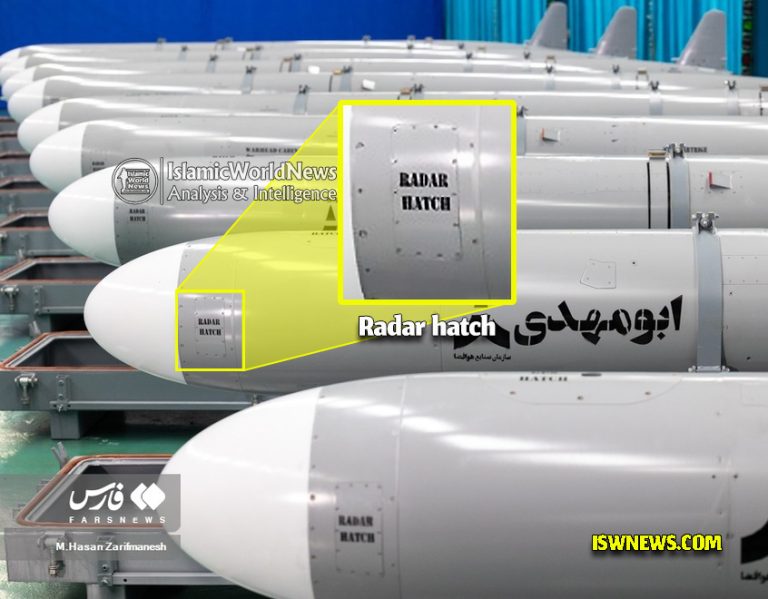
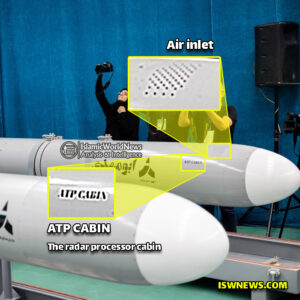
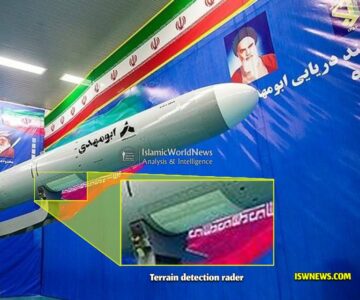
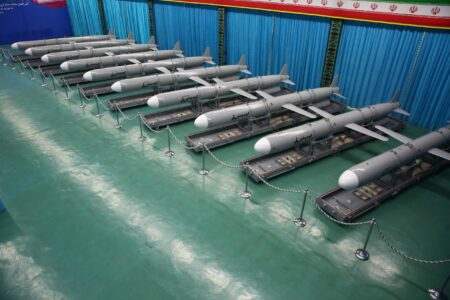
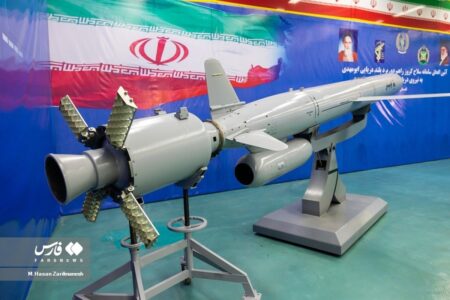
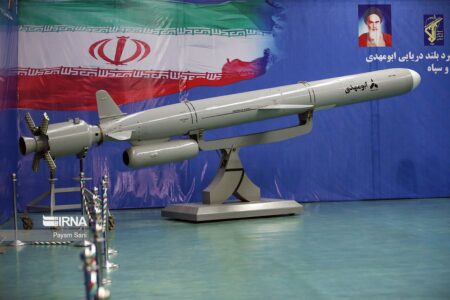
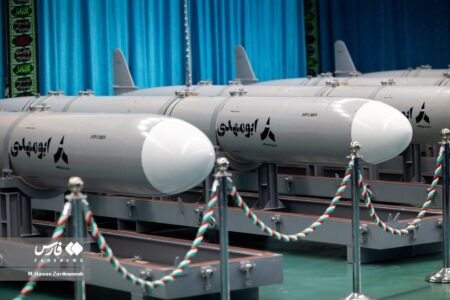



that will make the zionist cowards crap for a while.
israel will destroy that mullah shithole once and for all…
israeli cunts cant even get rid of hezbollah
tak to už je poriadny zabijak len čo je pravda.